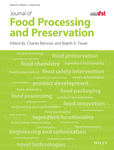Effects of chitosan coating containing lysozyme or natamycin on shelf-life, microbial quality, and sensory properties of Halloumi cheese brined in normal and reduced salt solutions
Funding information: University of Jordan (Deanship of Research and Graduate Studies)
Abstract
The effects of chitosan (C) coating with or without lysozyme (L) or natamycin (N) on shelf-life, microbial quality, and sensory properties of Halloumi cheese held at 3 °C or 25 °C in 5%, 10% or 15% (w/v) NaCl were examined. Coatings increased cheese shelf-life by ≥ 5 days than the control when brined in 5% and 10% NaCl at 3 °C but did not affect the shelf-life of cheese in 15% NaCl. Nonetheless, coatings reduced psychrotrophs, anaerobes, lactic acid bacteria, and yeasts and molds by 1.8 to 2.2 log in 15% brined cheese. Reductions of microbial species contaminating Halloumi cheese at 10% and 15% brine were not significantly different with CL and CN coatings throughout storage at 3 °C. Coatings did not adversely affect sensory properties of cheese. Therefore, brine concentration could be reduced to 10% for CL and CN-coated cheeses.
Practical applications
Results support the possibility of reducing the high salt concentration in brine solution of Halloumi cheese by using a chitosan coating containing lysozyme or natamyc in which provided similar shelf-life and microbial stability. The coatings did not adversely affect the sensory properties of cheese and can be applied by a simple step during processing which facilitates their use in the food industry.




